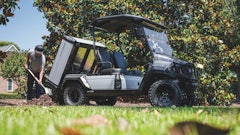
There are a lot of vehicle options out there for hauling around landscaping crews, tools and material. Gas- and diesel-powered UTVs have been workhorses for decades, but times are changing. Electric vehicles and equipment have become more and more prevalent in the green industry, making many landscape contractors consider whether it’s time to make the switch from gas and diesel power to electric. By exploring the realities of lithium-powered electric UTVs, landscape professionals can make better-informed decisions for their operations.
Electric vehicles, including UTVs for landscaping crews, have numerous strengths, including:
1. Lower emissions
Lithium battery-powered electric UTVs produce zero emissions from use. This not only means cleaner air around the job site, but it can also help landscape contractors meet customer demands, including from large businesses, nonprofits and local governments with big environmental initiatives to individual customers who simply want to hire contractors that prioritize going green. Some lithium battery-powered UTVs can reduce greenhouse gas emissions from vehicle use by more than 75% over the estimated life of the vehicle compared to gas UTVs. Lithium batteries also produce less harmful waste over their lifetime than older lead acid batteries that have traditionally powered electric vehicles.
2. Lower lifetime ownership costs
Electric UTVs have lower operating costs compared to their gas and diesel counterparts. Electricity is generally cheaper, and electric vehicles require less frequent maintenance, as they have fewer moving parts and do not require oil changes. These lower operating costs can often more than cover the initial investment over the life of the machine.
3. Quieter operation
Another advantage of electric UTVs is that they’re more pleasant to drive and be around while in operation. They are notably quieter than gas-powered UTVs, leading to less of a noise burden for both the operator and bystanders. This not only reduces noise pollution in general, but also maintains a quieter work environment in residential landscaping project areas or other areas with noise restrictions.
4. Motor performance
Gas-powered UTVs have a long track record of performance, especially in rough terrain where their power and torque are needed, but electric vehicles have been quickly closing the performance gap. Not only are electric motors more powerful than ever, but they deliver instant torque for fast acceleration and responsiveness behind the wheel.
5. Incentives
Many states and localities offer tax incentives or rebates for businesses that transition to electric vehicles, making the upgrade more financially attractive. Ask your dealer if there are any incentive programs in your local area that you may be able to take advantage of.
Are Electric UTVs Right for You?
Before making the jump and upgrading to electric UTVs, landscape professionals need to carefully weigh their options. Here are a few additional factors they should take into consideration:
1. Initial cost
Electric vehicles can cost more to purchase compared to traditional gas- or diesel-powered options, but that initial investment is often offset over time by savings in fuel and maintenance costs, as well as by potential incentive programs. You will also want to consider any initial electrical infrastructure upgrades that might be necessary to keep your fleet of electric UTVs up and running. Look for dealers that are experienced with electric vehicles, and they should be able to help ensure you have the proper setup. It could be as simple as having power outlets that can handle your average household appliances.
2. UTV Range and run time
An electric UTV’s range and run time depends on its battery life and your application’s demands. Driving on flat pavement will draw down battery power far more slowly than off-roading on rough terrain or steep slopes. Plus, different electric models are better suited for certain applications than others. Over the years, battery life has gotten drastically better, especially with lithium batteries replacing lead acid batteries, but some UTVs may require more frequent recharging.
3. Battery replacement costs
At some point in the future, you may need to replace your UTV’s battery. That said, battery technology is continually evolving, and performance is expected to improve in the future as costs decrease. Be sure to ask your dealer about the typical battery life of the electric UTVs you are considering and how long the battery is under warranty.
Deciding whether to upgrade your landscaping UTVs to electric is a decision that requires careful consideration. For the right operation, electric-powered UTVs have a lot of upsides, and current trends are making it easier for landscape contractors to take the plunge.
As battery technology continues to evolve, the performance and reliability of electric UTVs are getting better and better. The newest electric UTVs with lithium batteries offer enhanced range, power and features that make them ideal for landscaping needs, even in the most demanding applications on rough terrain. Furthermore, as industries continue to prioritize sustainability, upgrading your equipment to electric not only enhances your marketability to an environmentally conscious customer base, but also allows you to take advantage of local, state and federal incentive programs to save money.
Now could be a great time to make the switch. As the landscaping industry evolves, embracing electric UTVs may not only be a smart business decision, but also a step toward a greener future.















![U8kj71gt 720[1]](https://img.greenindustrypros.com/mindful/acbm/workspaces/default/uploads/2025/10/u8kj71gt-7201.8OyDyc124u.jpg?ar=16%3A9&auto=format%2Ccompress&fit=crop&h=135&q=70&w=240)




